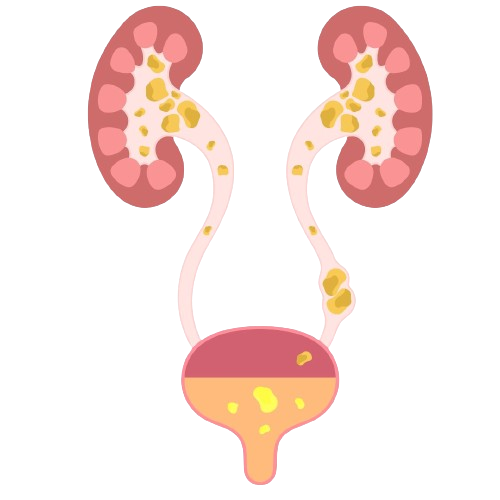
Expert Urologists. Holistic Health. Seamless Procedures
Leading the Way in Urological Innovation: Every Stage of Life
Dr. Rohit as profession Best Urologist in Mathura at Verma Hospital are dedicated to providing you with the best Urology hospital therapy available, whether you're looking for standard urological care or exceptional care. Put your trust in a professional who is committed to your well-being and producing outstanding results when it comes to your fitness.

What Is Urology ?
In the field of medical treatments the specialty of urology includes the recognition, therapy, and management of diseases that impact the urinary tract and reproductive system in both genders. In terms of male organs, this comprises problems related to the area surrounding the prostate gland, the testicles, the abdomen, and the kidneys along with the bladder, ureters, and urethra. Urologist specialists are experts in this field, treat fertility problems in men, kidney stones, bladder and prostate issues, urologic tumours, and urinary tract infections. They assign each clinical and surgical procedure to treat the ones difficulties and ensure gold standard health for the urinary and reproductive systems.
Dr. Rohit’s commitment to perfection can be seen in every area of his work.His meticulous attention to detail and dedication to treating patients have a major impact on Verma Hospital’s extraordinary reputation for scientific expertise. Patients under his care can anticipate a blend of modern technology, skill, and kind assistance.
1. Urinary Tract Infection -
All urinary system section, involving the ureter, bladder, kidneys, and urethra, can be harmed by a urinary tract infection (UTI). Commonly, microorganisms from the intestines tract—like E. Coli—enter the urinary system through the urethra and expand inside the bladder to produce UTIs. While there are numerous additional symptoms associated with UTIs, the most common ones involve burning or difficulty when pooping, black or smelly urine, and tightness in the lower back or abdomen. Women get urinary tract infections (UTIs) more frequently than men do, and being pregnant, sexual interest, aberrations in the urinary system, and other medical conditions are risk factors for UTI development.
Types of UTIs:
1. Cystitis (Bladder Infection): Infection of the bladder lining causing symptoms like frequent urination, burning sensation, blood in urine, and pelvic discomfort.
2. Urethritis (Urethra Infection): Infection of the urethra causing symptoms like burning during urination and discharge from the urethra.
3. Pyelonephritis (Kidney Infection): Severe infection of one or both kidneys, often resulting from bacteria ascending from the bladder, with symptoms like back pain, high fever, nausea, and vomiting.
Causes:
Bacterial Infection: Most commonly by E. coli from the digestive tract.
Sexual Activity: Increased sexual activity can introduce bacteria into the urinary tract.
Incomplete Bladder Emptying: Can cause bacterial buildup.
Blockages: Kidney stones or an enlarged prostate can trap urine in the bladder.
Catheter Use: Increases the risk of UTIs.
2. Bladder Blues -
Urinary tract infections (UTIs) and other bladder-related issues can cause pain or suffering that is sometimes referred to as the “bladder blues.” It describes the warning signs and symptoms of bladder infections, such as urgency, burning while urinating, frequent urination, pelvic pain, and perhaps blood in the pee.
The phrase “Bladder Blues” reflects the sense of discomfort and anxiety that usually accompany those symptoms, as they can cause soreness and interfere with daily activities. It’s an explanation for the unattractive joy of dealing with bladder-related issues rather than a scientific era.
Causes:
Medication: Greenish-blue urine may be caused by some drugs, including stimulants like triamterene, amitriptyline, and cimetidine (Tagamet), which is used to cure acid reflux and ulcers.
Medical dyes: Several dyes used in bladder and kidney tests have the ability to make urine blue.
Unusual bacterial infection: a strain of Pseudomonas is an unusual bacterial infection that can also cause blue or purple urine.
3. Phimosis -
When the penis’s foreskin becomes tight and is unable to fully retract over the penis’ head, also known as the glans, it is referred to as phimosis. Failure to pull down the foreskin can result in pain, cleanliness difficulties, along with other issues. Phimosis is frequently seen in young boys and infants, but it can also continue or get worse as people age for a variety of reasons.
Types :-
Physiological Phimosis
A congenital condition known as physiological phimosis occurs when a male newborn has a good foreskin at birth because of adhesions between the glans penis and the inner layer of the foreskin that make retraction difficult. This is not uncommon; non-retractability of the foreskin affects approximately 96% of toddler boys. These adhesions usually become weaker with time due to slow retraction, usually ending in a while 5-7. Merely 2% of instances continue until early adulthood or maturity.
Pathological Phimosis
Accidents, infections, rashes, scars, or illnesses such as lichen planus, psoriasis, or eczema can all result in pathological phimosis. These circumstances can lead to rough, itchy, and inflamed penile skin, and poor cleanliness can make the issue worse. When left untreated, pathological phimosis can spread to any age and is incurable, necessitating prompt medical attention. Retraction that was once possible but is now difficult to do may indicate pathological phimosis.
Causes:
Injury: The primary manifestation of phimosis is an impairment in the elasticity of the membrane due to tissue scarring from cuts, bacteria, or allergic reactions.
Diseases: This condition, posthitis, and ongoing infections of the glans or foreskin may trigger irritation and scarring, which might give rise to phimosis.
Inflammatory disorders Conditions: Skin issues such as fungi sclerosus might lead the outer layer of skin to become tight and thinner.
Trauma: Injuries like forced retraction that affect the penis or foreskin might result in scarring and tightness.
Recurrent Balanitis: Prolonged glantitis can leave scars and phimosis in their wake.
4. Hydrocele -
A hydrocele is a medical condition in which scrotal expanding results from excess fluid in the cartilage vaginal tissue, a pouch that contains the testicular organ. Genetic defects, trauma, infection, or unexplained conditions can all lead to this. A responding hydrocele in a baby arises from an open passageway that lets fluid pass between the abdominal cavity and the area known as the scrotum. This link disappears in water molecules that are non-speaking due to trauma or inflammation.
Scrotal enlargement, noticeable while standing or straining, and occasionally mild pain or heaviness are among the symptoms. A physical examination, transillumination (shining a light through the scrotum), and probably an ultrasound are required for the diagnosis. Treatment options range from observation to aspiration (fluid drainage) or surgical excision, depending on the size and symptoms of the hydrocele.
Types:
I. Congenital Hydrocele:
Communicating Hydrocele: Hydrocele that is communicative develops when the membrane of the vaginal tissue, which is a portion of the abdominal cavity, does not entirely close during healing. This allows fluid from the peritoneum to pass freely between the region of the scrotum and the abdomen. It commonly causes in young children and babies.
Non-Communicating Hydrocele: Hydrocele that doesn’t communicate with one another: This happens whenever the vaginal canal process ends, but fluid is still retained in the scrotal chamber. This type is most frequent among newborns and typically passes away on its own in the first year of life.
II. Acquired Hydrocele:
Primary Hydrocele: There is no underlying medical condition associated with this kind of hydrocele. The illness, that typically affects mature individuals, becomes brought on by a lack in the fluid flow and absorption that occur through tunica vaginalis, a tissue that surrounds the testicles.
Secondary Hydrocele: This kind is associated with underlying diseases such as systemic disorders (liver cirrhosis, coronary heart failure), trauma, tumours, and infections (e.g., epididymitis or orchitis). The documentation for Hydrocele in reaction to these circumstances.
III. Infantile Hydrocele:
This kind is comparable to a congenital non-communicating hydrocele, but it is more commonly seen in older children who have had a chronic hydrocele since early childhood.
IV. Hydrocele of the Cord:
This kind is comparable to a congenital non-communicating hydrocele, but it is more commonly seen in older children who have had a chronic hydrocele since early childhood.
V. Encysted Hydrocele:
This type no longer surrounds the testicle and is a localized fluid series next to the spermatic twine that isn’t usually connected to the peritoneal cavity. It looks like a beautiful structure shaped like a cyst.
5. Cyste -
A cyst is a formation that seems like a sealed cavity that can hold liquid, semi-solid, or gas. Cysts may appear in any area of one’s skin and can vary widely in size. They are often benign (not malignant), but occasionally they could be connected to severe circumstances or indicate a different medical problem.
Types:
Renal cysts: These are swelling kidney-containing sacs filled with fluid. These cysts could be simple or complex, and they might or might not cause symptoms. Simple kidney cysts are typically benign and don’t normally need to be treated, unless they result in headaches that include pain or contamination. To rule out malignancy, complex kidney cysts may also need additional investigation.
Ovarian cysts: They grow on the egg sac and contain cavities containing plasma. They are exceptionally common and are usually undetectable.The overwhelming majority of cysts in ovaries simply shrink within a few months and don’t need hospitalization.
Prostatic cysts: These cysts can develop within the gland that controls prostate function and create manifestations such as difficulty peeing urinary tract infections, or pain in the pelvic area. On a regular basis they may be correlated with diseases such as prostate infections or benign prostatic hyperplasia (BPH).
Epididymal cysts: The epididymal, a tube with a coil that hangs above the prostate gland, is where these enlargements form. They are usually harmless and are unlikely to trigger signs or symptoms, even though infrequently they may cause scrotal pain or swelling.
Causes:
Blocked ducts or glands: Cysts may develop when the frame’s ducts or organs stop working, causing it harder for liquids or different substances to drain properly. For instance, clogged oil glands in the skin might result in the formation of sebaceous cysts.
Infection: Cyst development may result from infections. For example, infections can cause cysts inside the ovaries or other organs to enlarge.
Chronic inflammatory situations: Conditions concomitant with acne or certain inflammatory diseases may raise the risk of cyst development.
Genetic elements: Cysts can occasionally be connected to hereditary disorders or genetic variables.
Trauma: Cysts can occasionally arise as a result of trauma or injuries to a specific area of the frame.
Hormonal adjustments: In some cases, positive fluctuations in hormone levels, such as those that arise during puberty, pregnancy, or menopause, might lead to the creation of cysts.
Tumors: A few cysts may be connected to tumours or other unusual growths.


